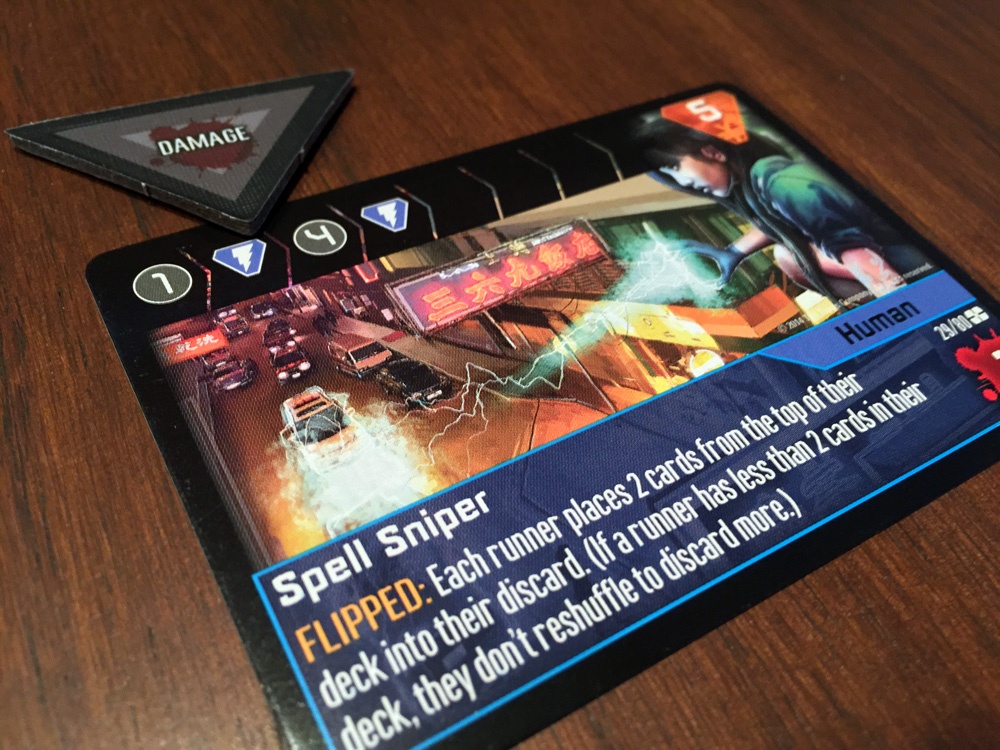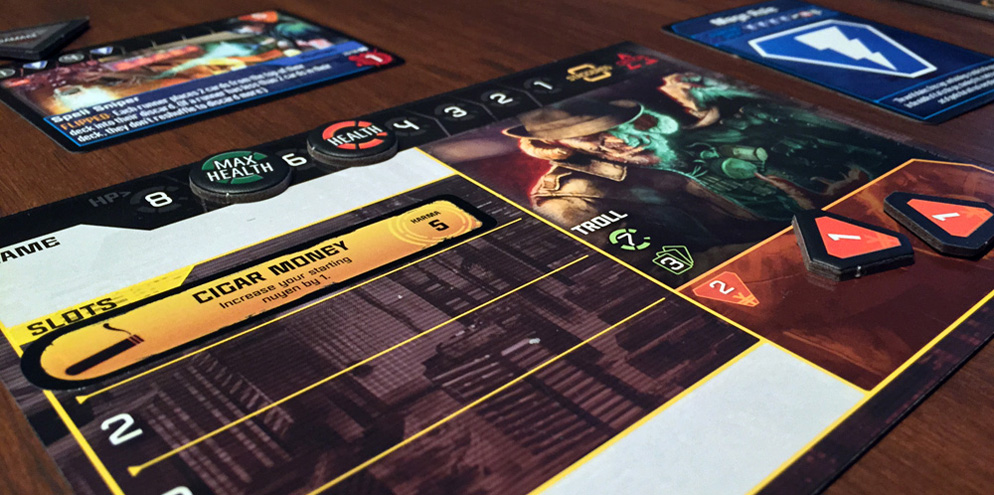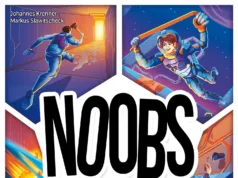 You’ve entered the gritty, cyberpunk fantasy world of Shadowrun. It’s a world filled with danger from the most unlikely sources: ultra-violent gangers, flesh-eating ghouls, backstabbing corporate raiders, and even dragons. You and your teammates are a group of runners. You spend your time slinging spells, hacking the matrix, taking that hard sniper shot and talking your way out of any situation. At the end of it all, your goal is to accomplish the mission and get paid.
You’ve entered the gritty, cyberpunk fantasy world of Shadowrun. It’s a world filled with danger from the most unlikely sources: ultra-violent gangers, flesh-eating ghouls, backstabbing corporate raiders, and even dragons. You and your teammates are a group of runners. You spend your time slinging spells, hacking the matrix, taking that hard sniper shot and talking your way out of any situation. At the end of it all, your goal is to accomplish the mission and get paid.
Does it sound like fun? I hope so because that’s the theme of today’s review of Shadowrun: Crossfire by Catalyst Game Labs. Set in their fantastic Shadowrun universe, this cooperative card game for 2-4 players will have your and your fellow players working as a well-oiled team of runners…for flat lining in the mud if the mission goes south. What’s it like to spend time in this game of hard obstacles and character advancement? Let’s find out!
Shadowrun: Crossfire is a cooperative deck building game for 2-4 players that plays in about 45 minutes. Shadowrun: Crossfire plays best with 4 players.
Game Overview:
Shadowrun: Crossfire has your team of runners embarking on missions in the world of Shadowrun. Most of the missions will have your team trying to overcome a series of increasingly harder obstacles. To do this, you will be playing cards from your hands and coordinating with your fellow players. Teamwork is essential as the world of Shadowrun can be particularly unforgiving. Play the right cards and overcome the obstacles, and your team will earn a fat paycheck of Nuyen (the worlds currency), which can be used to buy in game upgrades. If you can hold it together long enough to achieve the mission’s goals, then you’ll earn Karma points, which can be used to upgrade your character between missions. That’s right, games of Shadowrun: Crossfire have you playing the same character from game to game. With these great rewards also come risks, players must exercise caution as every runner needs to get out alive if you’re to succeed. If a teammate goes critical, it’s game over.
Components:

Shadowrun: Crossfire comes in a rather large size box compared to the components of the game. This doesn’t surprise me as this game is begging for expansions (which aren’t out yet), so for now, expect a lot of empty space in the box.
The main component of the game is the cards. They come in a few varieties: player cards, obstacles (both normal and hard), crossfire events and black market cards. All are well illustrated with thematic artwork and feel like they should hold up well to repeated play.
The game also comes with 10 character cards for you to choose to start building out your character. Each player will choose one and, ideally, run that same character across multiple games. You’ll also notice a few sheets of stickers (don’t cringe, it’s ok), but more on those later. The character themselves represent the different races in Shadowrun: Humans, Dwarves, Trolls, Elves and Ork. Each race has a different starting hit point value, hand size and Nuyen.
Finally, the game comes with a number of tokens, mission cards and other components to be used during the game. I should mention that the rulebook is a little quirky. It has a quick-start rule set in the beginning, and then goes on to the full rules in the second half of the book. Normally that’s fine, but the rules have you going back and forth between sections to get the full rules, so sometimes it can be a bit frustrating to find a particular rule.
How to Play:
Despite the size of the rulebook, Shadowrun: Crossfire is a fairly easy game to learn. To start, each player creates a character by taking a character card and a role. There are 4 roles in total to choose from: Mage, Decker, Street Samurai and Face. They all play similar; the only difference is the starting deck of cards. Each role starts with 3 of the matching color cards and one card each of the other 3 colors. You can choose the role that you feel best suits your play style, but during the game you can realistically buy any card you want. I tended to always buy blue cards for my mage, but every now and then I’d grab an out of color card.
Players then choose a mission to go on, the Crossfire mission is really the default mission and the one that will probably be played the most. We’ll use that one for this overview.
When you are ready to begin, each player is dealt out an obstacle card from the normal obstacle deck. Some obstacles may have a “flipped” effect, those effects happen when the card enters play.
Starting with the first player and continuing clockwise, each player takes a turn as follows:

1. Play Cards: Choose cards from your hand and play them next to an obstacle (even other player’s). These usually will damage the obstacle, and some also have special effects like healing or letting you cycle cards.
2. Apply Damage: Cards you played in step 1 now damage the obstacle. This is done via an icon system. There are 5 icons in the game (one for each of the 4 colors and one for any color). If the icon is a colored one, you just have to play a card that has a matching icon. If the icon is a grey number, you just need that many icons of any color. Each obstacle has a damage tracker that will move as you defeat its icons, which must be attacked from left to right. Beat them all and the obstacle goes to the discard pile and the runners split the Nuyen reward.
3. Take Damage: If there are any obstacles still in front of you still, your runner takes damage from it.
4. Draw and Buy Cards: If you have 3 or less cards in your hand, draw two cards. You can then buy any cards you can afford from the black market by spending your Nuyen. These cards go into your hand, not your discard pile. So they will be available to play next turn.
After that, the next player takes their turn. After everyone has gone, the round ends and a new one begins. At the start of the second turn of the game (and every round after that), the first player draws a Crossfire card before their turn. These represent the changing circumstances runners encounter during a run. Expect many too have effects that make a runners life harder. Some also have extra effects that only happen if the crossfire level is high enough. A crossfire level always equals the amount of cards in the crossfire discard, so it pays to end scenes quickly.
Each mission will have different requirements for winning, but in the Crossfire mission, players must beat each obstacle in front of them to end the scene. After all obstacles have been defeated, the scene ends and players start a new one, this time drawing one extra obstacle (possibly from the hard deck). After players have cleared all the obstacles in the third scene, the game ends and they win (collecting a 3 Karma reward). If a runner loses all their heath and goes critical, the game ends and the run is aborted. In an aborted run, the players have one chance to successfully escape (and earn a 1 Karma reward). If everyone goes critical the game ends in a failure and no one earns any Karma.

Game Experience:
For those of you that like your cooperative games to be hard (and they need to be, since its humans vs AI), you will be very pleased with Shadowrun: Crossfire. The world of Shadowrun can be quite deadly and Crossfire is no exception. Expect to lose, probably more often than you like. I think we have a nice 33% balance between winning, successfully aborting a run and complete failure.
And for me, it’s the failed runs that hurt the most as a big draw in Shadowrun: Crossfire is the character upgrade system. When you win, you get 3 Karma points to spend on upgrades (the cheapest upgrade is 5 Karma). When you have to abort a run, you get 1 Karma, and a failed run gets you nothing. Those Karma points are like the “donkey with the carrot” that will have you jumping back into the Shadowrun world again and again. I’m always excited to check out the sticker sheet at the end of a run to see if there is anything I could spend my hard earned Karma on.

Speaking of hard earned Karma, I should mention we house-ruled the rewards to bump them up a little. We made the gains 5/3 instead of 3/1. Unless you are planning on playing a lot of Shadowrun: Crossfire, it will be a long time between upgrade stickers. The first one comes fairly quickly, but after that, you could play 10 games before you got the second. For us, we wanted them a little more frequently. There is also a bit of a tax on Karma after you start acquiring stickers, so that made the decision a lot easier to house rule. If you are like me and have a lot of different games that you play, than there is nothing wrong with accelerating your upgrades a little bit.
Once you start acquiring these stickers, runs start to get a little bit easier. I think this is a combination of the bonuses from the upgrades and also from learning how to play the game better together. Those first few runs will be very difficult as you get a feel for the game. As I mentioned earlier, Shadowrun: Crossfire demands cooperation. Players have to work together to overcome obstacles. It almost feels as if each round is a puzzle just waiting to be solved. Players have a limited amount of cards in their hands each turn and they have to use them as efficiently as possible. There is no room for wasted turns in Shadowrun: Crossfire. If you don’t work together, the game will beat your runners into a bloody heap. I think it’s just natural to focus on the obstacle in front of you, but you really need to look around the table and see where the most efficient use of your cards lies.

Because you are playing a card game, sometimes even the most strategic teams can fall victim to the luck of the draw. I’ve noticed that Shadowrun: Crossfire can be prone to wild swings during the game. Sometimes we will feel like we are invincible, only to have a particularly nasty obstacle or crossfire card show up and beat a few of us down. As someone who’s spent some time in the Shadowrun universe, I feel like this does fit thematically. Runs never go prefect in Shadowrun, so it only makes sense that Shadowrun: Crossfire would play like that. That being said, it can be maddeningly frustrating to have 1 card draw turn your fates around so quickly. Still, it never really felt like the game is broken or unbalanced. Runs can sometimes be unpredictable. As we gained experience playing the game, we did learn to roll with those punches a little better.
And that’s where the Crossfire deck can be really clever. Make no mistake, you will fear those cards, but these are really thematic (in the context of runs) and help to keep the players on their toes. Without that deck, the game would lose a good amount of the tension it has. As you read earlier, the actual game play isn’t difficult, so I’m glad they added in these extra bits of excitement to keep the game entertaining.
I was actually a bit surprised at how much fun we’ve had playing Shadowrun: Crossfire. When I first read the rules, I wasn’t completely sold. The roles all felt kind of similar and we weren’t buying very many cards during a game. But after more games than I can even count now, I find myself getting drawn back into this box of cards again and again. I think it’s the intense cooperation and discussions I have during the game with my teammates. Every round we are strategizing the best things to do and how we are going to stay alive until the next scene. Crossfire is a very social game because the players must work together to survive. I really enjoy games that bring out conversations and dialogue like that.

Finally, I think that Shadowrun: Crossfire is just begging for expansions. I feel like I’ve seen all the cards in the Black Market a few times now and will be happy to get some more variety in there. There are also only a handful of missions right now (3 in the box, 1 online) and we usually just find ourselves playing the Crossfire one. I’m pretty excited to see what Catalyst Games has in store for Shadowrun: Crossfire and will be jumping on an expansion the first chance I can get.
Final Thoughts:
There are only a handful of campaign style games out there and I’m always excited to try out a new one. Shadowrun: Crossfire ended up being an easy to learn game that’s a lot of fun to play. Since players keep their cards hidden in their hands, “quarterbacking”, which is oh so common in cooperative games, is thankfully kept to a minimum. Players have to work together and everyone knows it. If one goes down, everyone does. This keeps the game tense, lively and very social. These are all great things in a cooperative game.
I should note that Shadowrun: Crossfire doesn’t scale the best; you really want to have 4 players going on your runs. I’ve tried with only two and it’s just not the same. If you are primarily a 2 player group, I’d recommend using 2 roles each (there are official rules for running with less than 4 in the rule book).
But my favorite part of Shadowrun: Crossfire has to be the character advancement. I’m really looking forward to getting my character sheet filled up with stickers. If you are looking for a thematic, campaign style card game, then give Shadowrun: Crossfire a chance. It will keep your entertained through many plays and the cyberpunk/fantasy universe is a great new theme that begs to be explored more. Pick this one up today.
If you are interested in getting a copy for yourself, you can get it for about $45.
Final Score: 4 Stars – A great campaign style card game that demands cooperation from its players. I can wait to see what the future holds for Shadowrun: Crossfire.
 Hits:
Hits:
• Easy to learn rules
• Great campaign style game play
• High player interaction
• Challenging game play
Misses:
• Game play is not the best with less than 4 players.
• Needs more missions
























I know you like the Pathfinder ACG a little less. How do you think the character development in this compares to that?
Pathfinder is definitely a little deeper when it comes to character development. Each character has unique powers and stats you get to choose from. Crossfire is just choosing which upgrade stickers you want. Both fun games, but I like the game play in Crossfire better.
Hi BoardGameQuest. I just wrote an article about this game and put a link to your post because I prefered your review than other bordgame websites;p
Hope you are fine with that and thank you.
AW